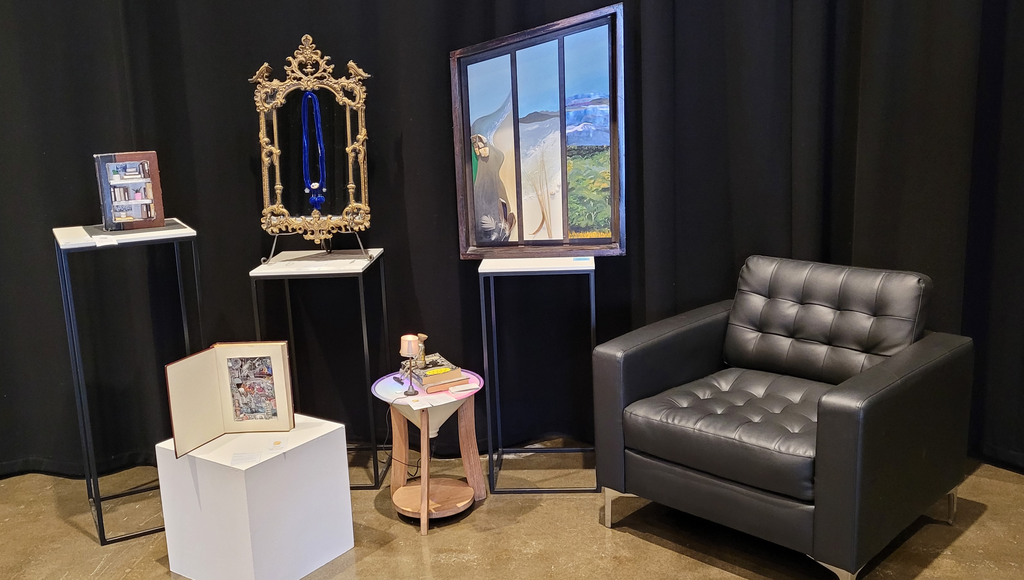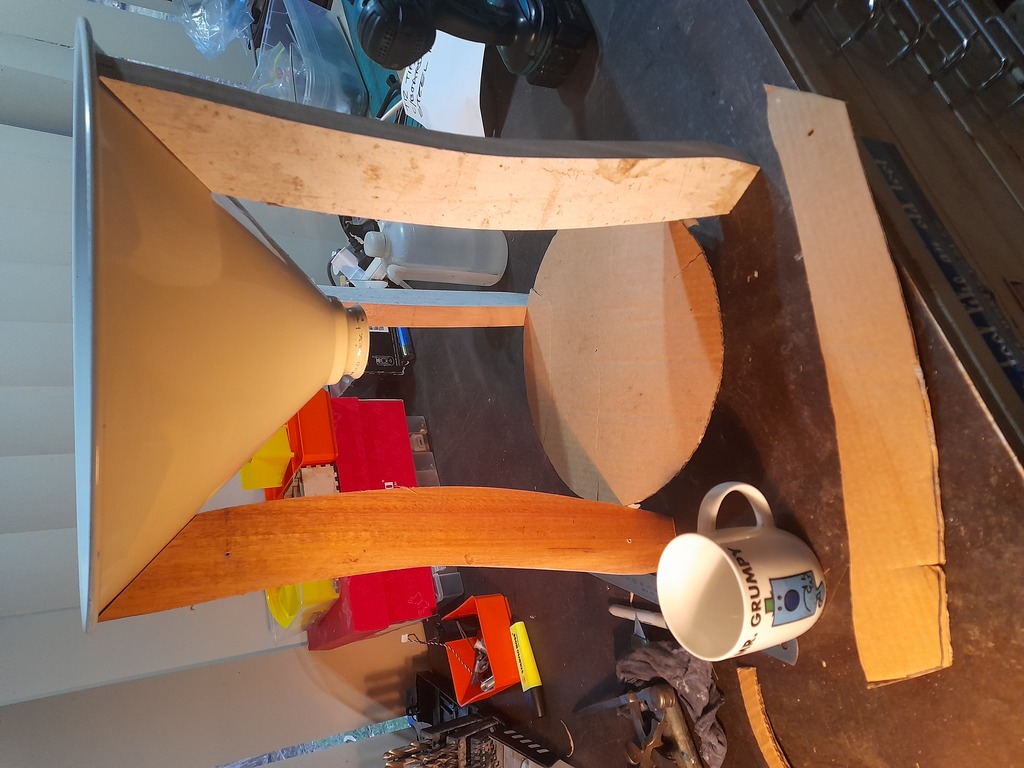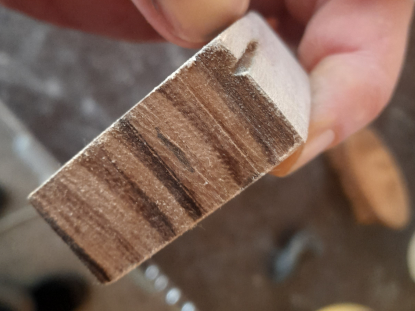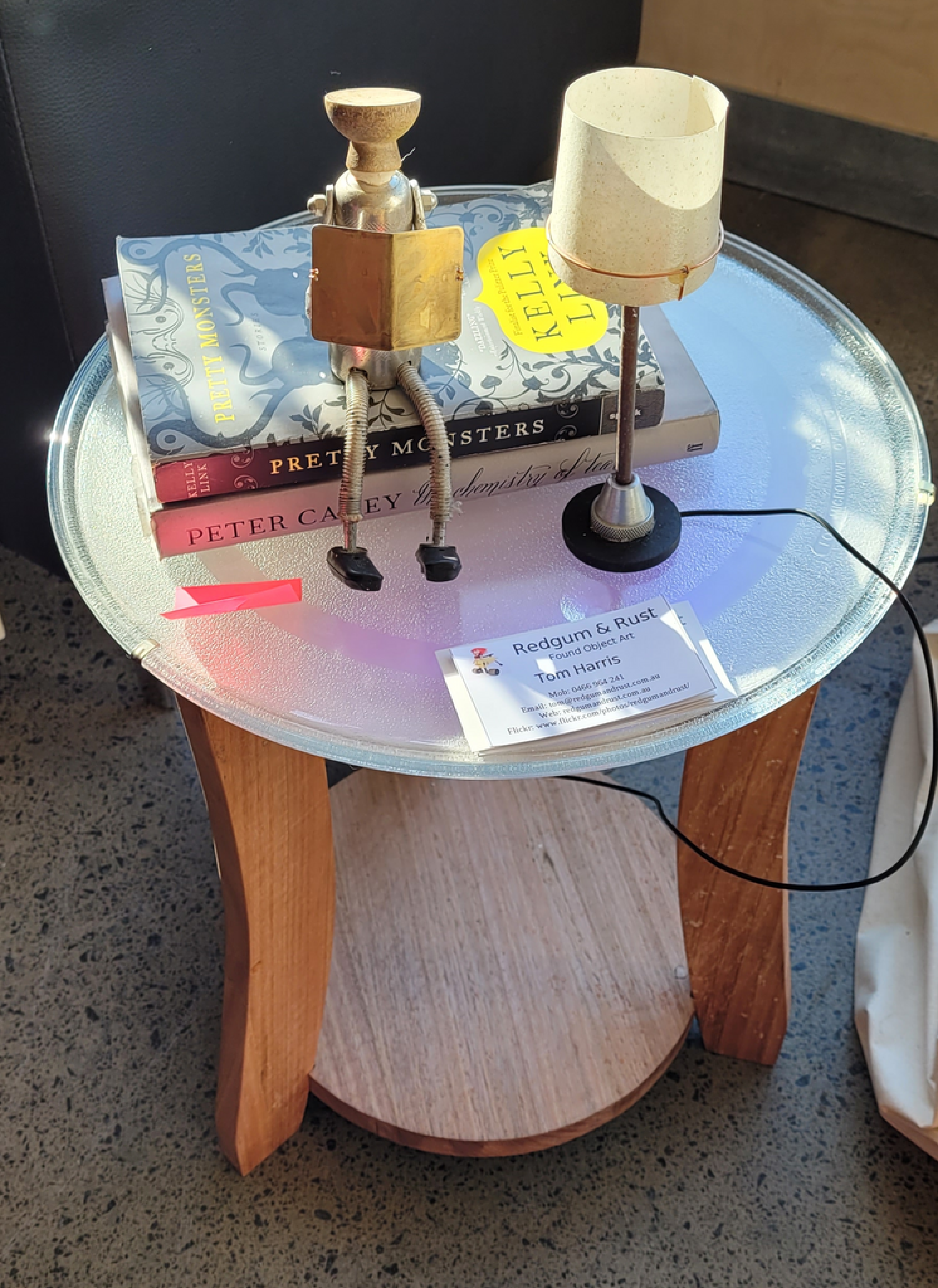Details
Size: 50cm x 50cm x 60cm high.
Materials: Lampshade and microwave oven plate from tip shop, legs are recycled furniture timber. Lights recycled Xmas decorations. Charger from e-waste. Books from my library, from op-shops. Reader made from miscellaneous workshop junk.
Date: 2023.
Note: requires mains power for lights.
Salvaged Art Exhibition Kingston 2023
I made My Happy Place for a recycled art show held in Kingston in 2023 (I entered I Made It Myself in 2021, the show is biennial). The theme was “Health & Wellbeing” and the direction was “Through your artwork, let us know what makes you feel joy, gratitude, hope, a sense of belonging or purpose and/or a connection to nature.”.
Here’s the artist’s description I wrote:
As well as making art my happy place is reading somewhere quiet. As you can see I
have combined a coffee table to hold a drink and a few books with a relaxing light
show and a recharge socket for my tablet.
Of course one of my little creations has found a congenial place to sit and read and
has moved in. As she’s no trouble at all I’ve let her stay.
I won the amateur artist award this time.
The curators made a sort of living room arrangement for a few themed pieces, I quite like the setting, even though mine does get a bit lost next to the ugly black armchair.

Materials
I’m splitting this up as the piece is really 3 parts.
Table
The inspirational part for this piece was the conical lampshade that I found at South Hobart Tip Shop, have I mentioned that this is one of the best tip shops I know? It was missing the fitting for the globe so I could use it with an easy conscience that I was not preventing something being used for its original prurpose. I also needed a library table for my reading room, and the shade would make a perfect base.
I made the top from an old microwave plate, for some reason there were 3 in the shed. It is quite a large one and fits perfectly on the shade. The only problem I had was holding it onto the shade. In the end I used 3 little clips made from picure hangers, but they are a bit flimsy and I should replace them with something stronger.
The legs were cut out of scrap hardwood I found in the shed. I have no idea what it was once part of, maybe furniture. It was fairly well used so had paint and dings on it, I sanded off the paint but left the dings, one shoudn’t erase history. I “designed” the profile of the legs by sketching a shape on cardboard and refining it until I decided I’d spent enough time with a Stanley knife and masking tape. Then I made a MDF template of the shape and cut out 3 legs on a router table with one of those bits that can follow a template stuck to the work. I call this process “CAD” which I use to mean “Cardboard Auded Design”.
The bottom circular shelf is a place a put more books and it was needed to tie the legs together, as the shade was soft aluminium so they wobbled and were not secure. It does look a bit thick when assembled, given more time I would have found a thinner bit or put a bevel on the edges to reduce the visual thickness.
Pro tip I learnt from theatre propmakers: if you don’t want something to wobble, give it 3 legs!
Here’s the legs attached minus the shelf. The somewhat battered cardboard design in in front.

Here’s an annoyyance of using recycled timber: you never know when you are going to cut through an old hole which then becomes very visible. A fine furniture maker would carefully fit in a piece of wood carved to fit. I just used filler.

A hole appears!
The bottom of the shade has a USB charger socket that I made with a broken car lighter plug adaptor. I use a power supply (donated to Hobart Hackerspace) to power it with the 12V it expects. Also (very importantly) there is a a brightness control, as sometimes you want things dialed down a bit. The LEDs mount on a circle of cardboard about half way up. The glass top has a sort of stippled finish on the bottom that does scatter the light a bit, but it was still a bit glarey. So I used another trick that I saw used in the theatre: frost gel, thick plastic sheet with a frosted finish, specifically made to diffuse light. A sheet of this under the top got exactly the look I wanted.
Lightshow
If somethings worth making its worth putting LEDs in it.
The lightshow inside is made from a strip or ribbon on tiny LEDs that can be stuck on just about anything, each LED (there are 22) can be programmed to any colour or brightness. I used one of my favourite electronics parts, an Arduino, a physically small cheap fairly brainless module that can control just about anything. I programmed it to generate a spectrum of pastel colours that slowly changed colour, repeating the sequence maybe in a minute.
The actual program is below. About half of it came as a demo and I just modified it until I was happy with the look. This is all that is running the LEDs and setting the brightness from a knob.
#include <FastLED.h>
FASTLED_USING_NAMESPACE
constexpr uint8_t DATA_PIN = A0;
constexpr uint8_t GPIO_BRIGHTNESS_POT = A1;
constexpr uint8_t GPIO_BRIGHTNESS_VCC = A2;
#define LED_TYPE WS2811
#define COLOR_ORDER GRB
constexpr uint8_t NUM_LEDS = 22;
constexpr uint8_t BRIGHTNESS_MIN = 17;
constexpr uint8_t FRAMES_PER_SECOND = 10;
CRGB leds[NUM_LEDS];
void setup() {
FastLED.addLeds<LED_TYPE, DATA_PIN, COLOR_ORDER>(leds, NUM_LEDS).setCorrection(TypicalLEDStrip);
FastLED.setBrightness(50); // Set default brightness until the main reads the control.
pinMode(GPIO_BRIGHTNESS_VCC, 1);
digitalWrite(GPIO_BRIGHTNESS_VCC, 1);
}
static uint8_t gHue;
void loop() {
fill_rainbow( leds, NUM_LEDS, gHue, 7);
FastLED.show();
FastLED.delay(1000 / FRAMES_PER_SECOND);
// do some periodic updates
EVERY_N_MILLISECONDS( 20 ) {
gHue++; // slowly cycle the "base color" through the rainbow
}
EVERY_N_MILLISECONDS(100) {
uint8_t b = (map(analogRead(GPIO_BRIGHTNESS_POT), 0, 1023, BRIGHTNESS_MIN, 255));
FastLED.setBrightness(dim8_video(b));
}
}
Reader
The tittle figure is a Reader, one of many little creatures who just sit on things reading. I made her years ago and never got around to giving her a book. The body is a tool for cleaning car battery terminals, legs are springs with bike brake blocks for feet. The head is a drawer pull.
Lamp
As I had a spare USB socket with volts coming out of it I thought I’d make a lamp. The globe is probably from an old car, the lampshade is some heat resistant material that came out of an old hairdrier, I held it together with copper wire that was used as part of an instrument that measured environmental conditions as it was dropped into the ocean, sending the results back up to the surface; very useful stuff.
Video
The show looks very pleasing and gentle, totally appropriate for a reading environment.
